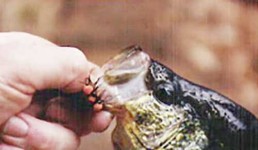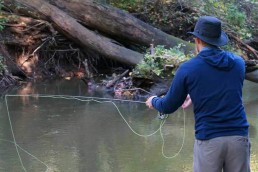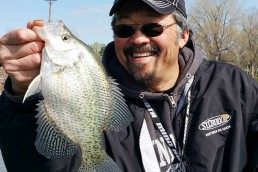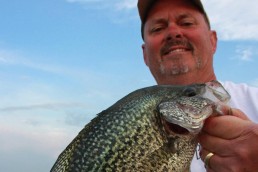Catching Crappies on the Fly with Success
SHARE THIS POST
Springtime is always thought of as “crappie time” and rightfully so. Their breeding and behavior patterns are made to order for the fishermen and women to fit between ice out and opening day of trophy fishing. They tend to be the first into the shallows but also the first to leave. While most people think of crappie poles tipped with jig and minnow or jig and twister tail, their shallow water behavior also lends itself to the use of a fly rod.
Crappies are generally an open water fish, but in the spring they are one of the first fish to come into shallows for breeding and feeding. Shallows, especially ones protected from the wind and with a southerly exposure, are the first to warm in the early spring. Many times, shallow bays will be ice-free long before the main body of a lake becomes open water.
This warm open water of course leads to plant and algae growth, which in turn leads to increased oxygen supply and that opens the door for a plethora of organisms that make up the food chain that ends in…crappies. Look for early crappies in shallow bays after two or three days of stable sunny weather. When the weather turns cold again they move back to their deeper water haunts.
Fly fishing tackle for crappies is about as simple as you can get. A medium length rod (seven to eight feet) designed for a 3, 4 or 5-weight line is sufficient. If you’re just getting into fly fishing, a 5/6 weight rod is easier to use when learning how to cast. A single-action reel filled with level or tapered line, a leader of 7 or 8 feet and a tippet in the 4X range will get you started.
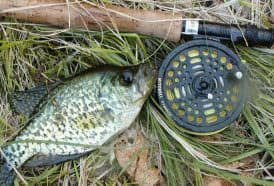
The choice of flies to use is as simple as the choice of rod. Spring crappies are not picky eaters. Fly size is probably the most critical factor. Spring food choices are going to be small so keep you offering small. Also, keep the hook size below 10. I prefer one of two styles. A leggy fly, one with lots of things sticking out from the body which imitates many of the insect larva that are emerging from the mud or a streamer style that has some sort of tinsel or marabou tail which imitates a minnow or other swimming morsel. If you are purchasing flies, a few suggestions are Black-Nosed Dace, Creek Chub, Bailou Special, Muddler Minnow. If you don’t want to invest in flies, ice fishing jigs with a tiny bit of pork rind work very well as does a plain hook with a small twister-tail. The nice thing about these two lures is that you can change colors and size without re-tying. Color is anyone’s guess, I just try different colors until I find one that the crappie prefer that day.
Are you enjoying this post?
You can be among the first to get the latest info on where to go, what to use and how to use it!
Just as with spin casting for crappie you can put a second fly 1-1/2 to two feet above the first. In most cases you will do better with some sort of a strike indicator A.K.A. bobber. The simplest is a small bobber that is used for ice fishing. It is small, adjustable and doesn’t affect casting. You can use the fly line itself as an indicator, when it moves away from you set the hook, but if the fish are not aggressive the bobber is a more sure way to go. A third way is to use a larger, high floating fly. This will act as both a strike indicator and as a lure for any surface activity.
Because crappies almost always relate to some sort of structure—especially the branches of downed trees—distance is not as important as the accuracy of a cast. Position the boat 20 to 25 feet from the area you want to fish. You are not going to shoot any line on the forward cast, but merely place it where you want the fly to land. Stripe off just enough line to reach where you want the fly to land. Unlike a spinning rig you don’t have to reel in to reposition your bait. Just pick up the line and one backcast and you have moved to a new location. That translates into more water time for your bait.
Little movement is the key to the type of action you should impart to the jig or fly. The water is still cold compared to summertime, so both fish and food are slow moving. I usually do not use any additional weight to speed up the decent of the fly. The fish are shallow to begin with and the slow decent of an unweighted fly looks more natural. It also keeps the fly in the strike zone for a longer period of time.
Early-season crappie fishing with a fly rod is a good way to introduce yourself or someone else to the joys of fly rodding. It’s a good opportunity that lets you catch fish while learning the basic techniques of casting and fly fishing.
MWO
SHARE THIS POST
Did you enjoy this post?
You can be among the first to get the latest info on where to go, what to use and how to use it!
Doug Thalacker
Doug Thalacker has a Masters of Environment Science from UW-SP and taught high school environmental science and earth science. He has outdoor/wilderness training through Outward Bound and American Red Cross. He has a lifetime of enjoying any activity that involves fields, woods or waters.
